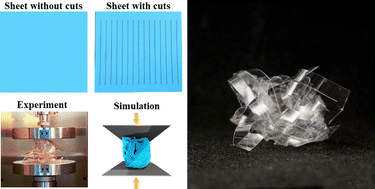Crumpled Kirigami†
Abstract
When a thin sheet is confined to a volume much smaller than its length (or width), it forms a complex state of sharp bends, point-like developable cones (d-cones) and extended ridges known as crumpled matter. One interesting feature of this state, is its high resistance to compression given its light weight. While the origins of this strength still remain a matter of debate, much has been learned through simple experiments and models. Very little work has explored how crumpling is affected by the sheet's topology, which is curious given the close relation between geometry and mechanics. In this work, we couple confocal microscopy with simple force experiments and coarse-grained molecular dynamics (CG-MD) simulations to explore how adding cuts to a sheet alters its behavior in the crumpled state. We find that cutting does not significantly alter the overall compressive behaviour: force scales as a power law irrespective of cuts and magnitudes are only slightly reduced by cutting. Remarkably, when examining regions of high curvature in the crumpled sheets we see evidence of significant changes in the distribution of curvature in cut sheets.



 Please wait while we load your content...
Please wait while we load your content...